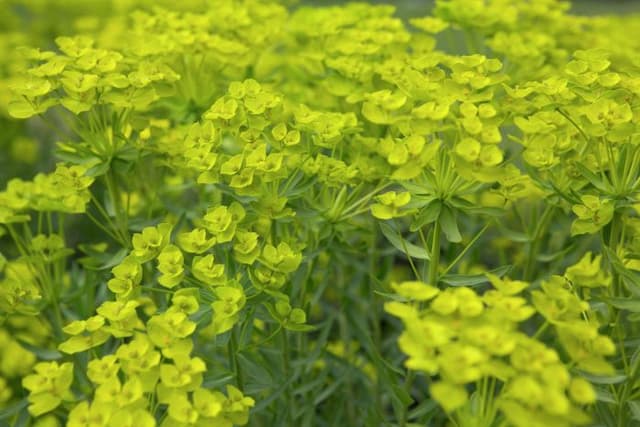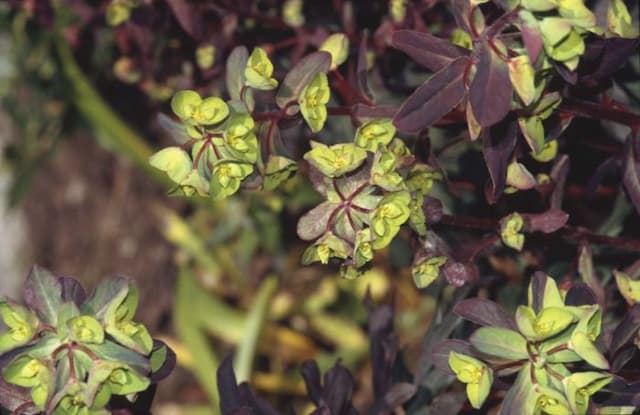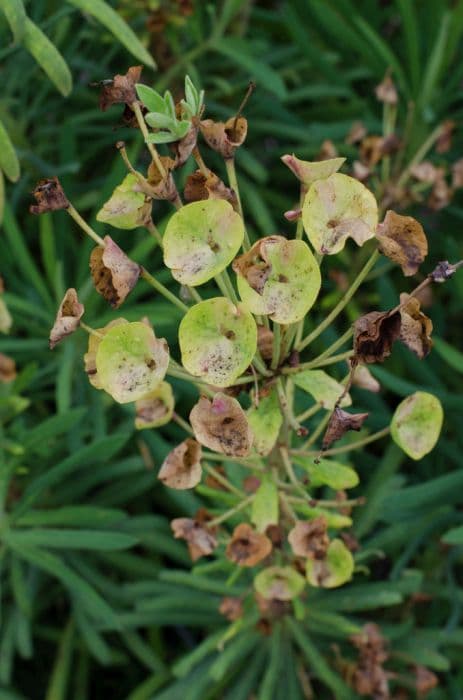Blue Haze Spurge Euphorbia 'Blue Haze'

ABOUT
Euphoria 'Blue Haze' is distinguishable by its beautiful, dense foliage that takes on a distinctive blue-gray hue, giving the plant its common name. The leaves are small, narrow, and often have a fine texture that can feel slightly rough to the touch. Over time, the foliage creates a dense, mounded form that can add a lush, textured appearance to garden spaces. Clusters of tiny flowers can be seen upon closer inspection. These flowers typically have a central eye-catching feature which is often surrounded by colorful bracts, that may come in shades of yellow, creating a striking contrast with the blue-gray foliage. The overall effect of the foliage combined with the bright, cheerful flowers makes Euphoria 'Blue Haze' a standout in any planting arrangement. Furthermore, although I will not specify the dimensions, it should be noted that, like many plants in its family, Euphoria 'Blue Haze' is adept at filling in spaces and creating a full, rounded silhouette. It is often used for its fantastic foliage and has a tendency to spread outwards, thus making it a valuable ground cover or accent plant in a garden setting.
About this plant
 Names
NamesFamily
Euphorbiaceae
Synonyms
Blue Haze Spurge, Spurge 'Blue Haze'
Common names
Euphorbia 'Blue Haze'
 Toxicity
ToxicityTo humans
Euphorbia 'Blue Haze', commonly known as spurge, contains a milky sap that is toxic to humans. This latex can cause skin irritation and inflammation upon contact. If it gets into the eyes, it can lead to severe eye irritation and possibly temporary blindness. Ingesting any part of the plant can cause gastrointestinal issues, such as nausea, vomiting, and diarrhea. The sap may also induce symptoms if absorbed through the skin or mucous membranes. Serious cases of poisoning can lead to more severe reactions and require medical attention.
To pets
Spurge is toxic to pets due to its milky sap, which contains irritants and toxins. If pets ingest any part of the plant, they might exhibit symptoms like vomiting, diarrhea, and drooling. The sap can cause skin and eye irritation as well. If a pet gets sap in its eyes, it can lead to eye injuries due to the intense irritation and rubbing. Ingestion of large amounts can be more dangerous and lead to more severe symptoms, potentially necessitating veterinary care.
 Characteristics
CharacteristicsLife cycle
Perennials
Foliage type
Evergreen
Color of leaves
Blue-green
Flower color
Yellow
Height
1-2 feet (30-60 cm)
Spread
1-2 feet (30-60 cm)
Plant type
Shrub
Hardiness zones
5-9
Native area
Mediterranean
Benefits
 General Benefits
General Benefits- Drought Tolerance: Euphorbia 'Blue Haze' is highly resilient in dry conditions, reducing the need for frequent watering.
- Low Maintenance: This plant requires minimal care, making it ideal for gardeners who prefer low-maintenance landscapes.
- Attracts Pollinators: The flowers of the Euphorbia 'Blue Haze' attract pollinating insects, beneficial for the health of your garden.
- Heat Resistance: It can withstand high temperatures, making it suitable for hot climates.
- Decorative Foliage: The silver-blue foliage provides a unique color contrast in the garden throughout the growing season.
- Deer Resistant: This plant is not a preferred choice for deer, helping to prevent damage from grazing.
 Medical Properties
Medical PropertiesThis plant is not used for medical purposes.
 Air-purifying Qualities
Air-purifying QualitiesThis plant is not specifically known for air purifying qualities.
 Other Uses
Other Uses- Euphorbia 'Blue Haze' can be used in miniature gardens as it adds texture and color contrast to the miniature landscape.
- They can serve as a natural pest deterrent in the garden due to the latex they emit, which can discourage certain insects from feeding on them and surrounding plants.
- As a dye plant, the latex or the bracts of Euphorbia 'Blue Haze' may be used in creating natural dyes for fabrics or crafting materials.
- The plant can be incorporated into xeriscaping, as its drought tolerance makes it an ideal choice for water-conservative gardening practices.
- Euphorbia 'Blue Haze' can be used as a model in botanical studies or educational programs to demonstrate plant adaptations to arid environments.
- It can act as a living mulch due to its low-lying and spreading growth habit, helping to retain soil moisture and suppress weeds.
- Euphorbia 'Blue Haze' can serve as a protective ground cover on slopes or banks to prevent soil erosion with its root system.
- Used in floral arrangements, its unique form and color can add an interesting dimension to both fresh and dried floral compositions.
- This plant can be featured in art and photography for its unique structure and color palette, inspiring botanical-themed artistic creations.
- In landscaping, Euphorbia 'Blue Haze' can be utilized as a filler plant to cover bare spots and provide a seamless visual transition between other garden elements.
Interesting Facts
 Feng Shui
Feng ShuiThe Spurge is not used in Feng Shui practice.
 Zodiac Sign Compitability
Zodiac Sign CompitabilityThe Spurge is not used in astrology practice.
 Plant Symbolism
Plant Symbolism- Resilience: Euphorbia 'Blue Haze', also known as spurge, typically symbolizes resilience due to its hardy and tough characteristics, thriving in challenging conditions where other plants might not survive.
- Protection: Spurge plants have a milky sap that can be irritating to the skin, which is often seen as a natural protective trait, symbolically extending to represent shielding and defense against harm.
- Persistence: The spurge has a persistent nature, being able to spread and persist in many environments, symbolizing determination and the ability to endure difficult situations.
- Healing: Historically, some Euphorbia species were used for their medicinal properties, and thus spurge can be associated with healing and the transition from illness to health.
 Water
WaterSpurge 'Blue Haze' should be watered thoroughly but infrequently, allowing the top inch of soil to dry out completely between waterings. Overwatering is a common mistake with the spurge, as it can lead to root rot. The plant prefers dry conditions, thus it's better to err on the side of underwatering than overwatering. Generally, watering once every 1 to 2 weeks with about 16 to 32 ounces of water should suffice, but always check the soil moisture before adding water. During the winter months, reduce watering further as the plant goes into dormancy.
 Light
LightSpurge 'Blue Haze' thrives in bright, direct sunlight but can tolerate partial shade. The ideal spot would receive at least six hours of direct sunlight daily. Avoid placing it in deep shade, as this can lead to poor growth and a reduction in the vibrancy of the foliage color.
 Temperature
TemperatureSpurge 'Blue Haze' prefers temperatures between 60 and 75 degrees Fahrenheit but can withstand temperatures as low as 30 degrees Fahrenheit and as high as 90 degrees Fahrenheit. Avoid exposing the plant to prolonged periods of extreme cold or heat, as this can impact its health and growth.
 Pruning
PruningPruning Spurge 'Blue Haze' helps to maintain its shape and encourage bushier growth. Prune in the late winter or early spring before new growth begins. Cut back up to one-third of the plant to remove any winter damage and to shape it. Pruning can be done annually, or as necessary to control the size of the plant.
 Cleaning
CleaningAs needed
 Soil
SoilSpurge 'Blue Haze' thrives in well-draining soil that can be a mix of potting soil, peat, and perlite or sand. Aim for a soil pH between 6.0 to 7.5 to ensure optimal growth.
 Repotting
RepottingSpurge 'Blue Haze' generally needs repotting every two to three years, or when it outgrows its container.
 Humidity & Misting
Humidity & MistingSpurge 'Blue Haze' does well in moderate humidity levels, similar to typical indoor conditions, without requiring any special humidity adjustments.
 Suitable locations
Suitable locationsIndoor
Place Spurge 'Blue Haze' in bright indirect light indoors.
Outdoor
Outdoors, grow Spurge 'Blue Haze' in a sunny spot with afternoon shade.
Hardiness zone
6-9 USDA
 Life cycle
Life cycleEuphorbia 'Blue Haze', commonly known as 'Blue Haze Spurge', begins its life cycle when seeds are sown in well-draining soil during warm seasons. Germination occurs with consistent moisture and warmth, leading to the emergence of seedlings, which then develop true leaves characteristic of Euphorbia species. As the plant matures, it forms a dense mound of blue-green foliage with a height and spread of about 12-18 inches. During spring and summer, it produces clusters of small, yellowish-green flowers surrounded by showy, long-lasting bracts that provide ornamental value. Over time, 'Blue Haze Spurge' may spread by self-seeding or cuttings can be taken to propagate new plants. In colder regions, the plant may die back in the winter but will typically resprout from the root system with the return of favorable conditions in spring.
 Propogation
PropogationPropogation time
Spring-Summer
Euphorbia 'Blue Haze', commonly known as Blue Haze Spurge, is typically propagated by taking stem cuttings. The best time to do this is in late spring or early summer when the plant is actively growing. To propagate, a gardener would carefully select a healthy stem and cut it using a clean, sharp knife or pruners; a length of 4-6 inches (10-15 centimeters) is ideal. It's important to allow the cut end to callous over for a few days, which helps prevent rot when the cutting is planted. The calloused cutting can then be inserted into a well-draining soil mixture. Keeping the soil moist but not waterlogged fosters root development. In a few weeks, the cutting will have rooted and can eventually be transplanted into a regular garden setting.









